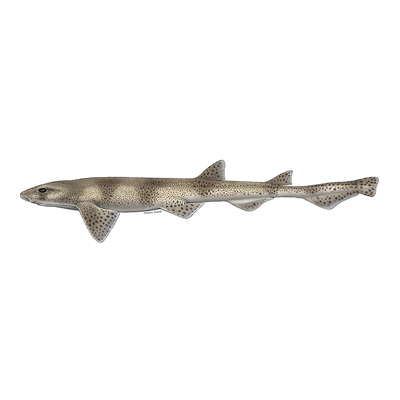

Murgey, Lesser spotted dogfish, or small spotted catsharks, are small sharks that live on and near the seabed. They have beautiful spotted skins that are covered in tough sandpaper like skin teeth. It is very difficult to remove this skin and as a result dogfish is rarely eaten in Cornwall and many fishermen use it as bait. It is however edible and sometimes marketed as ‘sweet William’.
Lesser spotted dogfish numbers appear to be stable and increasing in some areas possibly due to their toughness and the lack of demand and low price offered for them. Consumers should avoid eating sharks as generally they are vulnerable to over fishing due to the fact that they are slow growing, late to mature and produce few young each year. Landings are increasing each year.
160 tonnes of lesser spotted dogfish were landed to Cornish ports in 2021 with a total value of £40k (MMO data).
Updated July 2023
Cornish vessels landing to Cornish Ports
Demersal trawls are large nets that are pulled through the water with the bottom edge of the net touching the seabed. At each edge the net is pulled open by metal ‘trawl doors’. Sometimes referred to as Otter trawling.
Learn moreCornish vessels landing to Cornish Ports
Beam trawls are nets attached to a steel beam that holds the net open. The belly of the net is made of chains and the upper surface of the net is mesh. Beam trawlers pull two nets along the seabed simultaneously.
Learn moreCornish vessels landing to Cornish Ports
Gill nets are lightweight nets made of nylon (monofilament) fishing line that are anchored to the seabed and are used to catch fish by entangling the gills.
Learn moreCornwall Good Seafood Guide rates fish on sustainability using a scale of 1 to 5.
1, 2 and 3 are recommended, Fish to avoid are rated 5.
We use the system devised by the Marine Conservation Society (MCS) so our scores are comparable with the scores produced by MCS for the UK and fisheries from all around the world. For more information on scoring click here.
Scyliorhinus canicula. Lesser spotted dogfish (also known in Cornwall as Murgey) are small sharks that live on the seabed and grow up to 1m in length. They are harmless to humans although they have been known to cut anglers who handle them using their sharp, sandpaper like skin. They are found in depths of a few meters down to 400m. They are scavenging animals that opportunistically feed on a wide range of seabed invertebrates. They have a high vulnerability to fishing (62/100 ref Cheung et all 2005) as they have a slow growth rate and low reproductive rate. Dogfish egg cases (mermaids purses) are regularly seen on the strandline around Cornwall and finds of shark and ray eggs should be reported to www.sharktrust.org/en/great_eggcase_hunt.
This species is common and widespread around the UK coast but scientific analysis of its population has not been carried out in detail so the exact status of the stock is unknown, However using landings and catch data ICES scientist believe the stocks are increasing and that its range is also increasing. Fishing pressure is around MSY and biomass is above MSY according to ICES advice for a large area of the NE atlantic. As it has little commercial value there are likely to be high levels of discarding of this species and often the reporting of this species is poor making it harder for fisheries scientits to accurately assess stocks. This species is currently not highly valued and fishing effort is staying the same or declining as a result. ICES advise that the catches in 2024 can increase by 10% in the Celtic seas. ICUN redlist status least concern. Scores 3.5 on seafish Ecological risk Assessment for effects of south west fisheries – significant risk.
There is little management for this species. There is no minimum landing size or quota for lesser spotted dogfish. Currently there is little economic value in this species so landings are limited and management is currently appropriate. This will need to be monitored in future as if value increased there is little preventing this species being over fished.
Lesser spotted dogfish are taken as by-catch in trawl and net fisheries and are often found in crab pots too. They have a high survival rate when caught in pots and other fishing gears.






Cornwall Good Seafood Guide is underpinned by the Marine Conservation Society (MCS) Good Fish Guide. The first UK consumer guide to sustainable seafood. For more information visit www.fishonline.org
Cornwall Good Seafood Guide is here to help us all make sustainable seafood choices. Choices that will help us keep the oceans healthy and Cornish fishers' futures safe. This website is funded by Cornwall Wildlife Trust. If you would like to make a meaningful difference to the health of our oceans, please consider making a donation to the Cornwall Wildlife Trust Ocean Emergency fund. Your donation will help safeguard these remarkable environments, ensuring that they continue to thrive for generations to come. Together, we can be stewards of the seas and champions for a healthier, more sustainable future.